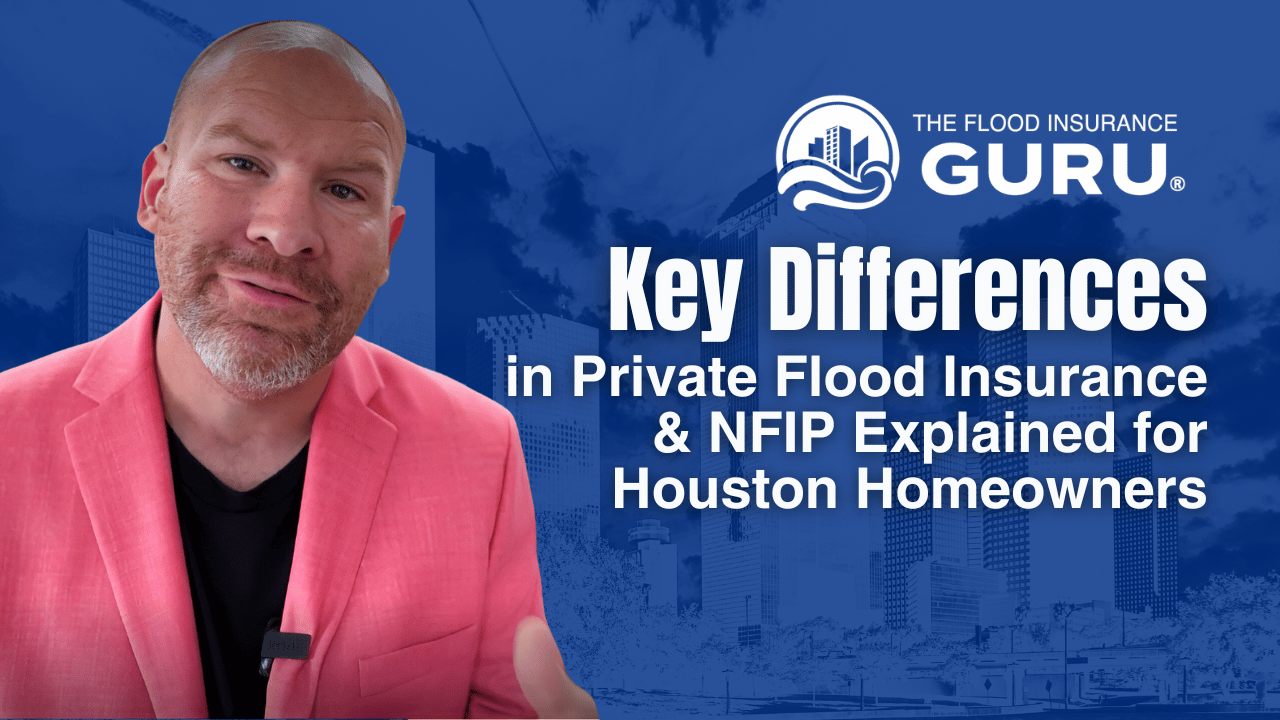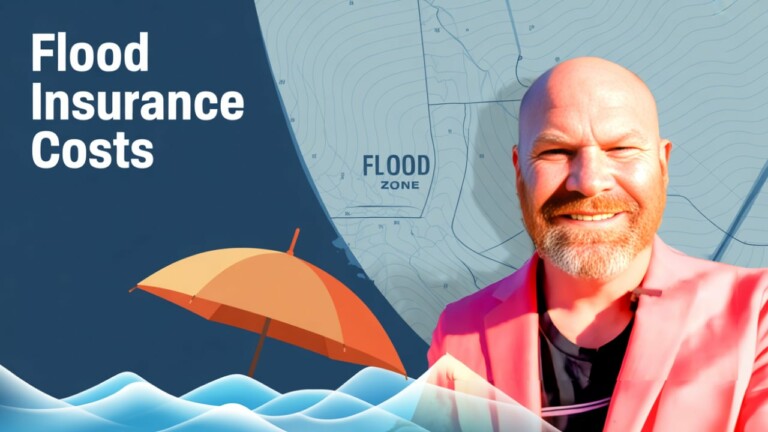Key Differences in Private Flood Insurance and NFIP Explained for Houston Homeowners
Are You a Houston Homeowner? Here’s What You Need to Know About Private Flood Insurance vs. NFIP
Are you a Houston homeowner trying to figure out the differences between the National Flood Insurance Program (NFIP) and private flood insurance?
If so, you’re probably wondering:
✅ Which flood insurance actually saves you money in Houston?
✅ Which policy will ensure you get fully reimbursed after a flood?
✅ Why do private insurers keep dropping policies in Houston?
✅ What happens if you cancel an NFIP policy? Will it cost you big bucks later?re you a Houston homeowner trying to figure out the differences between the National Flood Insurance Program (NFIP) and private flood insurance?
If so, you’re probably wondering:
✅ Which flood insurance actually saves you money in Houston?
✅ Which policy will ensure you get fully reimbursed after a flood?
✅ Why do private insurers keep dropping policies in Houston?
✅ What happens if you cancel an NFIP policy? Will it cost you big bucks later?
Are you a Houston homeowner trying to figure out the differences between the National Flood Insurance Program (NFIP) and private flood insurance?
If so, you’re probably wondering:
✅ Which flood insurance actually saves you money in Houston?
✅ Which policy will ensure you get fully reimbursed after a flood?
✅ Why do private insurers keep dropping policies in Houston?
✅ What happens if you cancel an NFIP policy? Will it cost you big bucks later?
Are you a Houston homeowner trying to figure out the differences between the National Flood Insurance Program (NFIP) and private flood insurance? If so, you’re probably wondering: Which flood insurance actually saves you money in Houston? Which policy will ensure you get fully reimbursed after a flood? Why do private insurers keep dropping policies in Houston? What happens if you cancel an NFIP policy? Will it cost you big bucks later?
Imagine This Scenario
After a hurricane floods their Houston home, Homeowner A has private flood insurance, which covers six months of Additional Living Expenses (ALE)—hotels, food, even some transportation—while repairs are underway.
Homeowner B has an NFIP policy. FEMA doesn’t cover ALE. They’re paying out-of-pocket for temporary housing, all while struggling to rebuild.
This is just one of the many critical differences between NFIP and private flood insurance that Houston homeowners need to know.
In this guide, we’ll break down:
✅ Premium differences in Houston (they’re bigger than you think!)
✅ How recent flood map changes affect pricing
✅ The 80% rule and how it can leave you underinsured
✅ Why Houston’s flood risk makes non-renewals a growing problem
After a hurricane floods their Houston home, Homeowner A has private flood insurance, which covers six months of Additional Living Expenses (ALE)—hotels, food, even some transportation—while repairs are underway. Homeowner B has an NFIP policy. FEMA doesn’t cover ALE. They’re paying out-of-pocket for temporary housing, all while struggling to rebuild. This is just one of the many critical differences between NFIP and private flood insurance that Houston homeowners need to know. In this guide, we’ll break down: Premium differences in Houston (they’re bigger than you think!), how recent flood map changes affect pricing, the 80% rule and how it can leave you underinsured, and why Houston’s flood risk makes non-renewals a growing problem.
Houston’s Unique Flood Risks—Why Your Insurance Choice Matters
Houston is one of the most flood-prone cities in the U.S., with risks including:
Houston is one of the most flood-prone cities in the U.S., with risks including:
- Storm surge flooding from the Gulf of Mexico (affecting areas near Galveston and Baytown)
- Flash flooding due to Houston’s flat topography
- Bayou overflow flooding (impacting neighborhoods like Meyerland and Kingwood)
Will Private Flood Insurance Actually Save You Money in Houston?
Across the US, private flood insurance often saves homeowners 50–60% over NFIP. But in Houston, that isn’t always the case. NFIP premiums are federally standardized, while private insurance varies by provider and risk models. Homes with a history of flooding often see higher private insurance rates—sometimes more expensive than NFIP. Additionally, recent flood map changes don’t impact NFIP pricing as much anymore (since 2022, NFIP uses Risk Rating 2.0 instead of just flood zones).
Across the U.S., private flood insurance often saves homeowners 50–60% over NFIP. But in Houston, that isn’t always the case.
✅ NFIP premiums are federally standardized, while private insurance varies by provider and risk models.
✅ Homes with a history of flooding often see higher private insurance rates—sometimes more expensive than NFIP.
✅ Recent flood map changes don’t impact NFIP pricing as much anymore (since 2022, NFIP uses Risk Rating 2.0 instead of just flood zones).
📌
Private Flood Insurance vs. NFIP—Coverage Breakdown
What NFIP Covers (And What It Doesn’t)
|
Coverage Type |
NFIP |
Private Flood Insurance |
|
Building Coverage |
Up to $250,000 |
Higher limits available |
|
Contents Coverage |
Up to $100,000 |
Full replacement cost available |
|
Additional Living Expenses |
Not Covered |
Often Covered |
|
Loss of Rent Coverage |
Not Covered |
Often Covered |
|
Basements & Below-Ground Areas |
Limited Coverage |
More flexible options |
The 80% Rule—A Hidden Risk in Houston
- NFIP requires you to insure at least 80% of your home’s replacement cost.
- If you don’t meet this requirement, your payout may be based on actual cash value instead of full replacement.
- Many Houston homeowners don’t realize this until they get underpaid on a claim.
📌
Private Flood Insurance Non-Renewals in Houston—Why It’s Happening
Many private insurers are dropping flood policies in Houston. Here’s why: High flood claim frequency is increasing risk for insurers, reinsurance costs are skyrocketing after major storms like Hurricane Harvey, and some homes are classified as “severe repetitive loss” properties, making them uninsurable. If you cancel an NFIP policy, you may not be able to re-enroll later at the same rate.
Many private insurers are dropping flood policies in Houston. Here’s why:
✅ High flood claim frequency is increasing risk for insurers
✅ Reinsurance costs are skyrocketing after major storms like Hurricane Harvey
✅ Some homes are classified as “severe repetitive loss” properties, making them uninsurable
👉 If you cancel an NFIP policy, you may not be able to re-enroll later at the same rate.
Filing a Flood Insurance Claim—Why Private Insurers Pay Out Faster
One of the biggest frustrations with NFIP claims is delays in processing.
One of the biggest frustrations with NFIP claims is delays in processing.
- Private flood insurance claims are settled 60% faster than NFIP claims.
- After Hurricane Ian, private insurers paid out claims months faster than FEMA.
- NFIP requires claims to be filed within 60 days of loss—miss this deadline, and your claim might be denied.
How Houston Homeowners Can Save on Flood Insurance
3 Ways to Lower Your Flood Insurance Premiums:
- Elevate your home or critical utilities (lowering flood risk can lower rates).
- Consider a higher deductible (but understand how multiple deductibles work).
- Compare private flood insurance policies before making a decision.
Conclusion—Which Flood Insurance Should You Choose in Houston?
At the end of the day, the best flood insurance option depends on your specific property, budget, and risk tolerance.
At the end of the day, the best flood insurance option depends on your specific property, budget, and risk tolerance.
- If you want standardized coverage and government-backed support, NFIP may be the safer bet.
- If you need additional coverages (like ALE or higher limits), private flood insurance could be the better choice.
- Always compare policies carefully—Houston’s flood risks make policy selection more critical than ever.
Next Step: Get a Flood Insurance Quote Today

Not sure which policy is best for you? Get a personalized flood insurance quote today and ensure your home is fully protected.
📌
Now that you understand how flood insurance rates are determined, it’s time to take action:
Navigating the Waters of Flood Insurance in COBRA Zones
When it comes to protecting your home from the unpredictable forces of nature, understanding your flood insurance options is crucial. Many homeowners find themselves navigating the complex landscape of flood insurance, especially when their property lies within a COBRA zone. You’ve asked, and we’re here to answer all your pressing questions about flood insurance in these unique areas.
What Exactly is a COBRA Zone?
What makes COBRA zones different from other flood zones, and why does it matter for my flood insurance?
COBRA zones, or Coastal Barrier Resources System areas, are designated by the federal government to protect natural coastal barriers. Development in these zones is discouraged to conserve natural habitats, minimize loss of human life, and reduce federal expenditure on infrastructure and disaster relief. For homeowners, this means that obtaining federal flood insurance through the National Flood Insurance Program (NFIP) is not an option, making it essential to explore alternative insurance solutions.
Can I Get Flood Insurance in a COBRA Zone?
They Ask: If federal flood insurance isn’t available in COBRA zones, what are my options for protecting my property?
You Answer: While properties in COBRA zones are ineligible for federal flood insurance, private flood insurance becomes a vital alternative. Private insurers offer policies designed to meet the unique needs of homeowners in these areas, ensuring you can secure the protection you need against flooding. It’s crucial to work with an insurance agent who understands the intricacies of flood insurance policies in COBRA zones to find the best coverage for your home.
How Do I Know If My Property is in a COBRA Zone?
They Ask: How can I determine if my property is located within a COBRA zone and understand the implications for my flood insurance coverage?
You Answer: Identifying whether your property is in a COBRA zone is the first step in navigating your flood insurance options. You can use tools like the CBRS Mapper provided by the Fish and Wildlife Service or consult with a knowledgeable insurance agent. Understanding your property’s location helps clarify your insurance options and ensures you’re pursuing the right coverage for your situation.
What Should I Look for in a Flood Insurance Policy?
They Ask: What key factors should I consider when choosing a flood insurance policy for my property in a COBRA zone?
You Answer: When selecting a flood insurance policy in a COBRA zone, consider coverage limits, deductibles, and exclusions. It’s also important to assess the insurer’s reputation and the policy’s provisions for claims handling. An insurance agent specializing in flood insurance can help you compare policies and choose one that offers comprehensive protection tailored to your needs.
Conclusion
Understanding flood insurance in COBRA zones doesn’t have to be a daunting task. By asking the right questions and seeking expert advice, you can navigate the complexities of securing the right flood insurance for your property. Remember, protecting your home from flooding is about ensuring your peace of mind and financial security, regardless of where you live.
Navigating the Waters of Flood Insurance in COBRA Zones
When it comes to protecting your home from the unpredictable forces of nature, understanding your flood insurance options is crucial. Many homeowners find themselves navigating the complex landscape of flood insurance, especially when their property lies within a COBRA zone. You’ve asked, and we’re here to answer all your pressing questions about flood insurance in these unique areas.
What Exactly is a COBRA Zone?
What makes COBRA zones different from other flood zones, and why does it matter for my flood insurance?
COBRA zones, or Coastal Barrier Resources System areas, are designated by the federal government to protect natural coastal barriers. Development in these zones is discouraged to conserve natural habitats, minimize loss of human life, and reduce federal expenditure on infrastructure and disaster relief. For homeowners, this means that obtaining federal flood insurance through the National Flood Insurance Program (NFIP) is not an option, making it essential to explore alternative insurance solutions.
Can I Get Flood Insurance in a COBRA Zone?
They Ask: If federal flood insurance isn’t available in COBRA zones, what are my options for protecting my property?
You Answer: While properties in COBRA zones are ineligible for federal flood insurance, private flood insurance becomes a vital alternative. Private insurers offer policies designed to meet the unique needs of homeowners in these areas, ensuring you can secure the protection you need against flooding. It’s crucial to work with an insurance agent who understands the intricacies of flood insurance policies in COBRA zones to find the best coverage for your home.
How Do I Know If My Property is in a COBRA Zone?
They Ask: How can I determine if my property is located within a COBRA zone and understand the implications for my flood insurance coverage?
You Answer: Identifying whether your property is in a COBRA zone is the first step in navigating your flood insurance options. You can use tools like the CBRS Mapper provided by the Fish and Wildlife Service or consult with a knowledgeable insurance agent. Understanding your property’s location helps clarify your insurance options and ensures you’re pursuing the right coverage for your situation.
What Should I Look for in a Flood Insurance Policy?
They Ask: What key factors should I consider when choosing a flood insurance policy for my property in a COBRA zone?
You Answer: When selecting a flood insurance policy in a COBRA zone, consider coverage limits, deductibles, and exclusions. It’s also important to assess the insurer’s reputation and the policy’s provisions for claims handling. An insurance agent specializing in flood insurance can help you compare policies and choose one that offers comprehensive protection tailored to your needs.
Conclusion
Understanding flood insurance in COBRA zones doesn’t have to be a daunting task. By asking the right questions and seeking expert advice, you can navigate the complexities of securing the right flood insurance for your property. Remember, protecting your home from flooding is about ensuring your peace of mind and financial security, regardless of where you live.
Navigating the Waters of Flood Insurance in COBRA Zones
When it comes to protecting your home from the unpredictable forces of nature, understanding your flood insurance options is crucial. Many homeowners find themselves navigating the complex landscape of flood insurance, especially when their property lies within a COBRA zone. You’ve asked, and we’re here to answer all your pressing questions about flood insurance in these unique areas.
What Exactly is a COBRA Zone?
What makes COBRA zones different from other flood zones, and why does it matter for my flood insurance?
COBRA zones, or Coastal Barrier Resources System areas, are designated by the federal government to protect natural coastal barriers. Development in these zones is discouraged to conserve natural habitats, minimize loss of human life, and reduce federal expenditure on infrastructure and disaster relief. For homeowners, this means that obtaining federal flood insurance through the National Flood Insurance Program (NFIP) is not an option, making it essential to explore alternative insurance solutions.
Can I Get Flood Insurance in a COBRA Zone?
They Ask: If federal flood insurance isn’t available in COBRA zones, what are my options for protecting my property?
You Answer: While properties in COBRA zones are ineligible for federal flood insurance, private flood insurance becomes a vital alternative. Private insurers offer policies designed to meet the unique needs of homeowners in these areas, ensuring you can secure the protection you need against flooding. It’s crucial to work with an insurance agent who understands the intricacies of flood insurance policies in COBRA zones to find the best coverage for your home.
How Do I Know If My Property is in a COBRA Zone?
They Ask: How can I determine if my property is located within a COBRA zone and understand the implications for my flood insurance coverage?
You Answer: Identifying whether your property is in a COBRA zone is the first step in navigating your flood insurance options. You can use tools like the CBRS Mapper provided by the Fish and Wildlife Service or consult with a knowledgeable insurance agent. Understanding your property’s location helps clarify your insurance options and ensures you’re pursuing the right coverage for your situation.
What Should I Look for in a Flood Insurance Policy?
They Ask: What key factors should I consider when choosing a flood insurance policy for my property in a COBRA zone?
You Answer: When selecting a flood insurance policy in a COBRA zone, consider coverage limits, deductibles, and exclusions. It’s also important to assess the insurer’s reputation and the policy’s provisions for claims handling. An insurance agent specializing in flood insurance can help you compare policies and choose one that offers comprehensive protection tailored to your needs.
Conclusion
Understanding flood insurance in COBRA zones doesn’t have to be a daunting task. By asking the right questions and seeking expert advice, you can navigate the complexities of securing the right flood insurance for your property. Remember, protecting your home from flooding is about ensuring your peace of mind and financial security, regardless of where you live.
Navigating the Waters of Flood Insurance in COBRA Zones
When it comes to protecting your home from the unpredictable forces of nature, understanding your flood insurance options is crucial. Many homeowners find themselves navigating the complex landscape of flood insurance, especially when their property lies within a COBRA zone. You’ve asked, and we’re here to answer all your pressing questions about flood insurance in these unique areas.
What Exactly is a COBRA Zone?
What makes COBRA zones different from other flood zones, and why does it matter for my flood insurance?
COBRA zones, or Coastal Barrier Resources System areas, are designated by the federal government to protect natural coastal barriers. Development in these zones is discouraged to conserve natural habitats, minimize loss of human life, and reduce federal expenditure on infrastructure and disaster relief. For homeowners, this means that obtaining federal flood insurance through the National Flood Insurance Program (NFIP) is not an option, making it essential to explore alternative insurance solutions.
Can I Get Flood Insurance in a COBRA Zone?
They Ask: If federal flood insurance isn’t available in COBRA zones, what are my options for protecting my property?
You Answer: While properties in COBRA zones are ineligible for federal flood insurance, private flood insurance becomes a vital alternative. Private insurers offer policies designed to meet the unique needs of homeowners in these areas, ensuring you can secure the protection you need against flooding. It’s crucial to work with an insurance agent who understands the intricacies of flood insurance policies in COBRA zones to find the best coverage for your home.
How Do I Know If My Property is in a COBRA Zone?
They Ask: How can I determine if my property is located within a COBRA zone and understand the implications for my flood insurance coverage?
You Answer: Identifying whether your property is in a COBRA zone is the first step in navigating your flood insurance options. You can use tools like the CBRS Mapper provided by the Fish and Wildlife Service or consult with a knowledgeable insurance agent. Understanding your property’s location helps clarify your insurance options and ensures you’re pursuing the right coverage for your situation.
What Should I Look for in a Flood Insurance Policy?
They Ask: What key factors should I consider when choosing a flood insurance policy for my property in a COBRA zone?
You Answer: When selecting a flood insurance policy in a COBRA zone, consider coverage limits, deductibles, and exclusions. It’s also important to assess the insurer’s reputation and the policy’s provisions for claims handling. An insurance agent specializing in flood insurance can help you compare policies and choose one that offers comprehensive protection tailored to your needs.
Conclusion
Understanding flood insurance in COBRA zones doesn’t have to be a daunting task. By asking the right questions and seeking expert advice, you can navigate the complexities of securing the right flood insurance for your property. Remember, protecting your home from flooding is about ensuring your peace of mind and financial security, regardless of where you live.
Information contained on this page is provided by an independent third-party content provider. This website make no warranties or representations in connection therewith. If you are affiliated with this page and would like it removed please contact editor @producerpress.com







